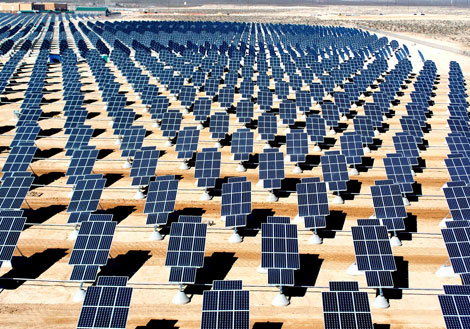Interior, Defense and Energy Departments Team Up to Advance Renewable Energy on Public Lands
The renewable energy side of President Obama’s “all-of-the-above” energy strategy received a significant boost in the past two weeks, with a veritable relay of Department of Energy, Interior and Defense actions on clean energy.
On July 24, the Department of Energy (DOE) and Department of the Interior (DOI) released the Final Programmatic Environmental Impact Statement (PEIS) for solar energy development in six southwestern states—Arizona, California, Colorado, Nevada, New Mexico, and Utah. The Final PEIS identifies 17 “Solar Energy Zones,” totaling about 285,000 acres of public lands, as priority areas for utility-scale solar development, with the potential for additional zones through ongoing regional planning processes. The identified Solar Energy Zones (see map) will have access to existing or planned transmission, relatively minimal resource conflicts, and incentives for development. This analysis should make for faster, smarter permitting of large-scale solar projects on public lands.
Two weeks later, DOI and the Department of Defense (DOD) announced that they signed a Memorandum of Understanding (MOU) to encourage development of renewable energy projects on public lands dedicated to defense-related purposes. The MOU is intended to strengthen the nation’s energy security and reduce the U.S. military’s utility costs, estimated at $4 billion per year.
Greater access to local renewable energy will help military bases maintain critical functions in the event of commercial grid failure and insulates bases from energy price spikes and shortages. Moreover, larger renewable projects could provide excess power back to the commercial grid, potentially making the military a net energy provider if appropriate reliability and security measures are in place.
With intermittent energy sources like solar and wind, advanced microgrid and energy storage technologies must also be part of the process in order to have reliable, secure energy. While the MOU does not go into detail on energy storage or microgrids, a June 2012 MIT report analyzes potential microgrid and energy reliability technology on Department of Defense land.
The MOU establishes a “Renewable Energy Partnership Plan,” which aims to coordinate DOI and DOD management of public lands – particularly 13 million acres of withdrawn lands located in the Southwest which present unique land use and permitting issues. The MOU describes a new pilot interagency process for authorizing solar energy projects on several military installations in Arizona and California, including the Barry M. Goldwater Range in Arizona and Fort Irwin in California.
Finally, the U.S. Army Corps of Engineers issued a solicitation last week to procure up to $7 billion of locally-generated renewable and alternative energy through long-term power purchase agreements. The solicitation will enable the Army to purchase electricity from renewable energy generators that will be financed and operated by private-sector contractors. Projects may be sited on private land or on installations within DOD’s jurisdiction, offering ample opportunities for private developers who are willing to navigate the government contracting process.
This solicitation stems from the DOD’s mandate that the Army produce or procure at least 25% of its total facility energy needs from renewable sources by 2025 and complements the Army’s own Net Zero Energy initiative. Assistant Secretary of the Army for Installations, Energy and Environment Katherine Hammack described the rationale for these Army renewable energy programs succinctly back in September: “We’ve got the land and we’ve got the demand.”







Reader Comments